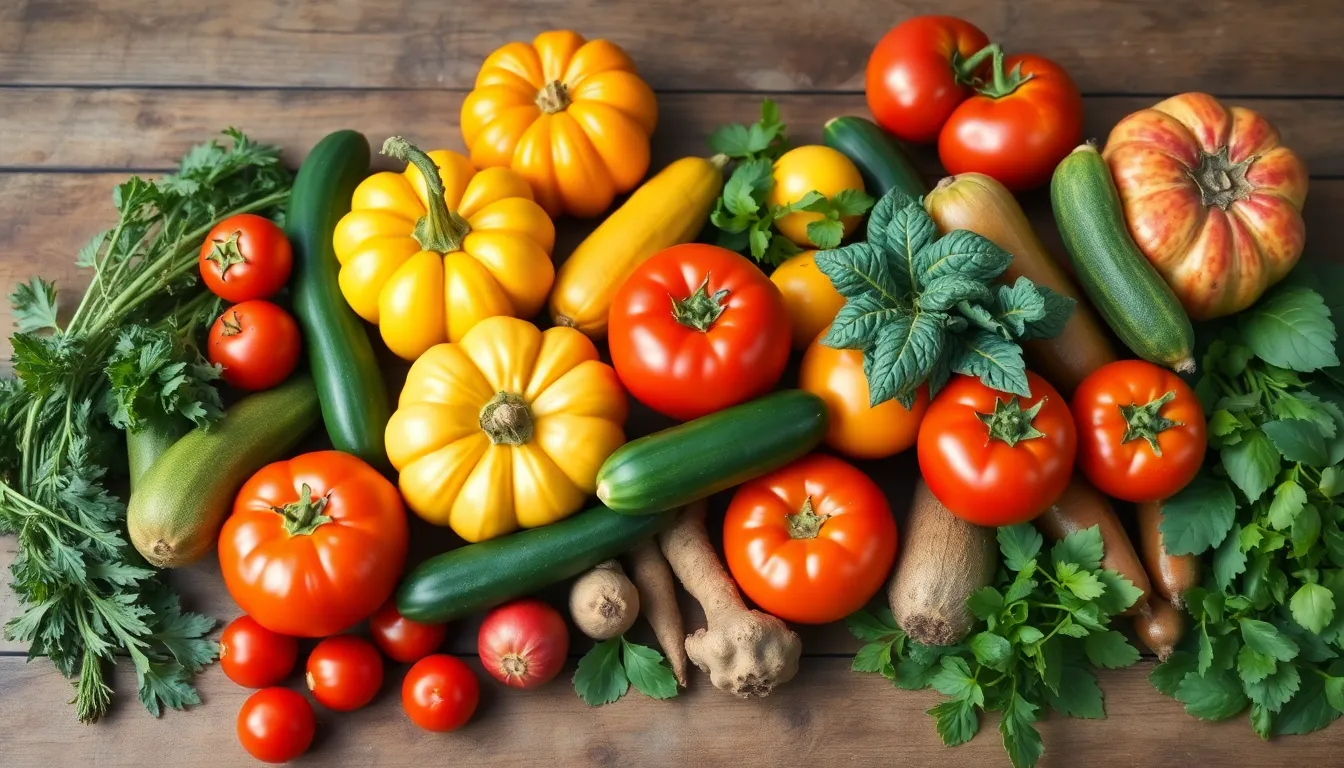In a world where takeout boxes outnumber reusable bags, it’s time to spice things up with sustainable recipes that not only tickle the taste buds but also give Mother Earth a warm hug. Imagine whipping up a meal that’s so delicious, it makes your taste buds dance while your conscience sings. Who knew saving the planet could be so tasty?
Sustainable Recipes
Sustainable recipes focus on using ingredients and methods that minimize environmental impact. These recipes prioritize local produce, seasonal ingredients, and plant-based alternatives.
What Are Sustainable Recipes?
Sustainable recipes consist of meals that rely on eco-friendly practices. They often feature ingredients grown without harmful pesticides or genetically modified organisms. Many cooks choose to incorporate whole foods, such as grains, legumes, and vegetables, which reduce carbon footprints. Recipes may also include foraged items or produce sourced from local farms to support community agriculture. Another principle involves using the entire ingredient, minimizing waste and promoting efficiency.
Importance of Sustainability in Cooking
Sustainability in cooking promotes health for individuals and the planet. Eating locally reduces transportation emissions, contributing to lower greenhouse gas levels. This practice encourages biodiversity by supporting varied farming methods. Incorporating seasonal ingredients enhances flavor profiles and nutritional content. Investing in sustainable cooking fosters awareness of food sources and encourages mindful consumption. Reducing over-reliance on animal products can also lower water usage and land degradation. Sustainability matters for future generations’ food security and environmental health.
Key Ingredients for Sustainable Recipes

Sustainable recipes rely heavily on choosing the right ingredients. Here are essential components that promote eco-friendly cooking.
Seasonal Produce
Utilizing seasonal produce enhances both flavor and nutrition. Fruits and vegetables available during specific times of the year often taste better and contain more nutrients. Local farmers often provide these ingredients, which reduces transportation emissions. Cooking with seasonal items supports local agriculture while lowering the carbon footprint. Examples include tomatoes and cucumbers in summer, and squash and root vegetables in fall. By prioritizing seasonal options, cooks can create vibrant dishes that celebrate nature’s bounty.
Plant-Based Proteins
Plant-based proteins serve as crucial components in sustainable recipes. Ingredients like beans, lentils, and tofu offer excellent sources of protein while minimizing environmental impact. These alternatives require significantly fewer resources compared to animal-based proteins. Incorporating legumes into meals helps reduce greenhouse gas emissions associated with livestock farming. Nutritional benefits accompany these proteins, such as fiber, vitamins, and minerals. Meals featuring a variety of plant-based proteins provide wholesome sustenance while addressing sustainability concerns.
Local and Organic Options
Local and organic options contribute significantly to sustainable cooking practices. Choosing organic produce minimizes pesticide use and promotes healthier ecosystems. Supporting local farmers strengthens community ties while ensuring fresher ingredients. Foods grown nearby often contain fewer preservatives and travel shorter distances to reach consumers. Organic dairy, meats, and grains also prioritize sustainability by encouraging humane farming practices. By selecting local and organic ingredients, individuals make conscious choices that benefit both personal health and the environment.
Cooking Techniques for Sustainability
Sustainable cooking techniques enhance both flavor and environmental impact. Energy-efficient methods reduce energy consumption while preparing meals.
Energy-Efficient Cooking Methods
Using appliances like pressure cookers and slow cookers conserves energy. These devices cook food thoroughly, minimizing cooking time and reducing electricity use. Utilizing lids on pots and pans retains heat and cuts energy requirements. Induction cooktops heat food faster than traditional methods, resulting in lower energy bills. Baking in batches saves time and energy while producing multiple meals. Overall, choosing the right equipment and cooking techniques makes a significant difference in energy usage.
Minimizing Food Waste
Minimizing food waste starts with proper planning. Creating meal plans and shopping lists prevents overbuying and encourages thoughtful purchases. Utilizing leftovers creatively transforms excess food into new dishes. Freezing extra portions ensures food longevity, reducing spoilage. Composting scraps enriches soil, benefiting gardens without chemical fertilizers. Prioritizing these waste-reducing strategies contributes to sustainability efforts, promoting a healthier planet and conserving resources.
Delicious Sustainable Recipes
Sustainable cooking offers tasty options that benefit both health and the environment. Explore these delicious ideas for breakfast, lunch, dinner, snacks, and desserts.
Breakfast Ideas
Start the day with overnight oats made from rolled oats, almond milk, and seasonal fruits. This nutritious meal minimizes prep time while maximizing flavor. Another option includes a veggie-packed frittata featuring local vegetables and organic eggs. Alternatively, try smoothies using frozen fruits and leafy greens for a refreshing boost.
Lunch and Dinner Options
Enjoy a hearty quinoa salad mixed with roasted seasonal vegetables and a zesty lemon dressing. Plant-based dishes like lentil curry not only nourish but also reduce environmental impact. For dinner, consider a stir-fry that incorporates locally sourced vegetables and tofu. Using whole grains like brown rice enhances nutritional value while supporting sustainable practices.
Snacks and Desserts
Craft energy bites with oats, nut butter, and local honey for a quick, healthful snack. For dessert, choose a fruit crumble made with organic apples and a whole grain topping, offering sweetness without excess sugar. Another excellent option features dark chocolate bark mixed with nuts and dried fruit, satisfying cravings while promoting conscious consumption.
Tips for Incorporating Sustainable Recipes into Daily Life
Incorporating sustainable recipes into daily routines enhances both health and environmental impact. With practical strategies, anyone can embrace a more eco-friendly cooking lifestyle.
Meal Planning Strategies
Start by selecting recipes that align with seasonal ingredients. Prioritizing these elements leads to fresher flavors and supports local farmers. Create a weekly menu to reduce impulsive purchases while ensuring variety and balance. Assess pantry items before shopping, which minimizes waste and avoids duplicate purchases. Utilize leftovers creatively in new meals, transforming potential waste into delicious dishes. Designate specific days for plant-based meals, which can lower one’s carbon footprint significantly.
Grocery Shopping Tips
Focus on local farmers’ markets, where fresh, seasonal produce often appears. Support organic vendors to ensure sustainable practices and reduced pesticide use. Opt for bulk bins when buying grains and nuts, which decreases packaging waste. Select reusable bags instead of single-use plastic to lessen environmental impact. Inspect labels for sustainable certifications, which indicate responsible sourcing. Engage with store staff about their sustainability initiatives; their insights can guide informed choices.
Conclusion
Embracing sustainable recipes transforms not just meals but also the way individuals interact with the environment. By prioritizing local and seasonal ingredients, cooks can create dishes that are both flavorful and eco-friendly. This mindful approach to cooking fosters a deeper connection to food and encourages healthier choices.
Incorporating energy-efficient techniques and minimizing waste further enhances the sustainability of home cooking. As people adopt these practices, they contribute to a broader movement toward environmental stewardship. Ultimately, sustainable cooking is a rewarding journey that satisfies both the palate and the planet, paving the way for a healthier future for generations to come.
